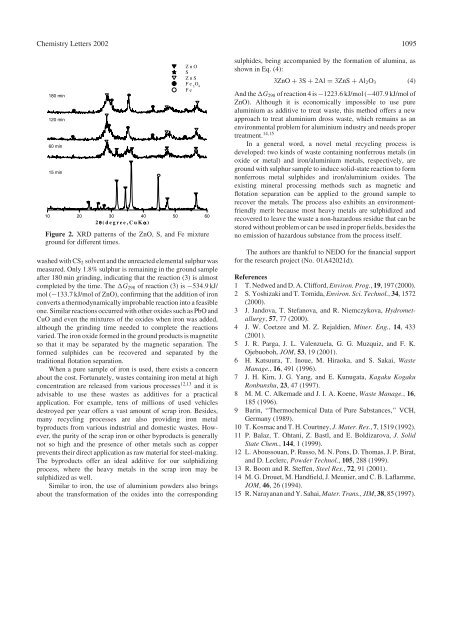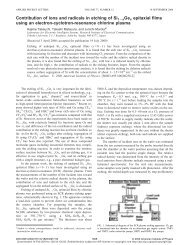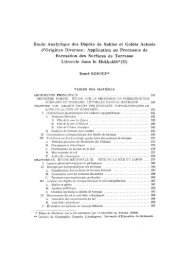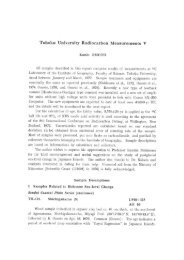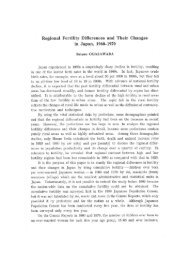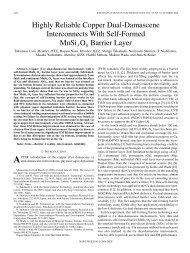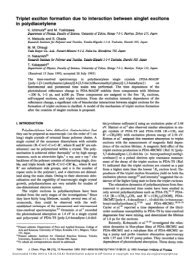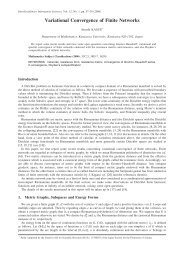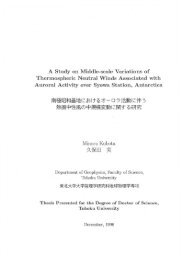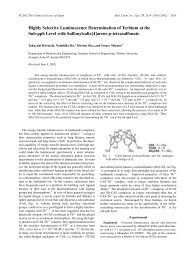Sulphidization of Metal Oxides by Means of Mechanochemical Solid ...
Sulphidization of Metal Oxides by Means of Mechanochemical Solid ...
Sulphidization of Metal Oxides by Means of Mechanochemical Solid ...
You also want an ePaper? Increase the reach of your titles
YUMPU automatically turns print PDFs into web optimized ePapers that Google loves.
ChemistryLetters 2002 1095<br />
10<br />
180 min<br />
120 min<br />
60 min<br />
15 min<br />
Z n O<br />
S<br />
Z n S<br />
F e O 3 4<br />
F e<br />
20 30 40 50 60<br />
2 θ (degree,CuKα )<br />
Figure 2. XRD patterns <strong>of</strong> the ZnO, S, and Fe mixture<br />
ground for different times.<br />
washed with CS2 solvent and the unreacted elemental sulphur was<br />
measured. Only1.8% sulphur is remaining in the ground sample<br />
after 180 min grinding, indicating that the reaction (3) is almost<br />
completed <strong>by</strong>the time. The G298 <strong>of</strong> reaction (3) is 534:9 kJ/<br />
mol ( 133:7 kJ/mol <strong>of</strong> ZnO), confirming that the addition <strong>of</strong> iron<br />
converts a thermodynamically improbable reaction into a feasible<br />
one. Similar reactions occurred with other oxides such as PbO and<br />
CuO and even the mixtures <strong>of</strong> the oxides when iron was added,<br />
although the grinding time needed to complete the reactions<br />
varied. The iron oxide formed in the ground products is magnetite<br />
so that it maybe separated <strong>by</strong>the magnetic separation. The<br />
formed sulphides can be recovered and separated <strong>by</strong>the<br />
traditional flotation separation.<br />
When a pure sample <strong>of</strong> iron is used, there exists a concern<br />
about the cost. Fortunately, wastes containing iron metal at high<br />
concentration are released from various processes 12;13 and it is<br />
advisable to use these wastes as additives for a practical<br />
application. For example, tens <strong>of</strong> millions <strong>of</strong> used vehicles<br />
destroyed per year <strong>of</strong>fers a vast amount <strong>of</strong> scrap iron. Besides,<br />
manyrecycling processes are also providing iron metal<br />
<strong>by</strong>products from various industrial and domestic wastes. However,<br />
the purity<strong>of</strong> the scrap iron or other <strong>by</strong>products is generally<br />
not so high and the presence <strong>of</strong> other metals such as copper<br />
prevents their direct application as raw material for steel-making.<br />
The <strong>by</strong>products <strong>of</strong>fer an ideal additive for our sulphidizing<br />
process, where the heavymetals in the scrap iron maybe<br />
sulphidized as well.<br />
Similar to iron, the use <strong>of</strong> aluminium powders also brings<br />
about the transformation <strong>of</strong> the oxides into the corresponding<br />
sulphides, being accompanied <strong>by</strong>the formation <strong>of</strong> alumina, as<br />
shown in Eq. (4):<br />
3ZnO þ 3S þ 2Al ¼ 3ZnS þ Al2O3 ð4Þ<br />
And the G298 <strong>of</strong> reaction 4 is 1223:6 kJ/mol ( 407:9 kJ/mol <strong>of</strong><br />
ZnO). Although it is economicallyimpossible to use pure<br />
aluminium as additive to treat waste, this method <strong>of</strong>fers a new<br />
approach to treat aluminium dross waste, which remains as an<br />
environmental problem for aluminium industryand needs proper<br />
treatment. 14;15<br />
In a general word, a novel metal recycling process is<br />
developed: two kinds <strong>of</strong> waste containing nonferrous metals (in<br />
oxide or metal) and iron/aluminium metals, respectively, are<br />
ground with sulphur sample to induce solid-state reaction to form<br />
nonferrous metal sulphides and iron/aluminium oxides. The<br />
existing mineral processing methods such as magnetic and<br />
flotation separation can be applied to the ground sample to<br />
recover the metals. The process also exhibits an environmentfriendlymerit<br />
because most heavymetals are sulphidized and<br />
recovered to leave the waste a non-hazardous residue that can be<br />
stored without problem or can be used in proper fields, besides the<br />
no emission <strong>of</strong> hazardous substance from the process itself.<br />
The authors are thankful to NEDO for the financial support<br />
for the research project (No. 01A42021d).<br />
References<br />
1 T. Nedwed and D. A. Clifford, Environ. Prog., 19, 197 (2000).<br />
2 S. Yoshizaki and T. Tomida, Environ. Sci. Technol., 34, 1572<br />
(2000).<br />
3 J. Jandova, T. Stefanova, and R. Niemczykova, Hydrometallurgy,<br />
57, 77 (2000).<br />
4 J. W. Coetzee and M. Z. Rejaldien, Miner. Eng., 14, 433<br />
(2001).<br />
5 J. R. Parga, J. L. Valenzuela, G. G. Muzquiz, and F. K.<br />
Ojebuoboh, JOM, 53, 19 (2001).<br />
6 H. Katsuura, T. Inoue, M. Hiraoka, and S. Sakai, Waste<br />
Manage., 16, 491 (1996).<br />
7 J. H. Kim, J. G. Yang, and E. Kunugata, Kagaku Kogaku<br />
Ronbunshu, 23, 47 (1997).<br />
8 M. M. C. Alkemade and J. I. A. Koene, Waste Manage., 16,<br />
185 (1996).<br />
9 Barin, ‘‘Thermochemical Data <strong>of</strong> Pure Substances,’’ VCH,<br />
Germany(1989).<br />
10 T. Kosmac and T. H. Courtney, J. Mater. Res., 7, 1519 (1992).<br />
11 P. Balaz, T. Ohtani, Z. Bastl, and E. Boldizarova, J. <strong>Solid</strong><br />
State Chem., 144, 1 (1999).<br />
12 L. Aboussouan, P. Russo, M. N. Pons, D. Thomas, J. P. Birat,<br />
and D. Leclerc, Powder Technol., 105, 288 (1999).<br />
13 R. Boom and R. Steffen, Steel Res., 72, 91 (2001).<br />
14 M. G. Drouet, M. Handfield, J. Meunier, and C. B. Laflamme,<br />
JOM, 46, 26 (1994).<br />
15 R. Narayanan and Y. Sahai, Mater. Trans., JIM, 38, 85 (1997).


